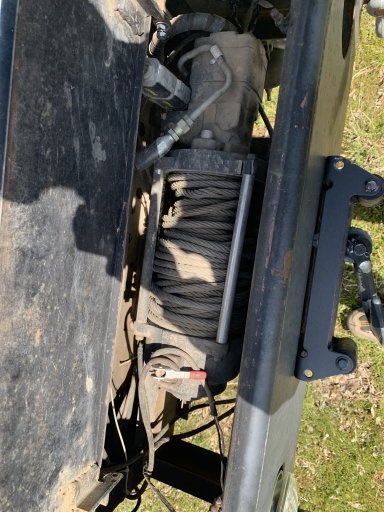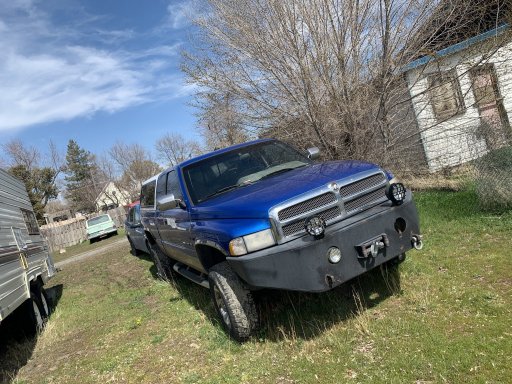
Contributor III

Contributor III

Advocate III
20990
You are going to want at least a 9500 series winch but I perso would go as far as your wallet will allow. I’m running a MileMarker 18,000 lb hydro winch. Not cheap, but after heavy use and 10 years, when I hit the switch it works...What winch is the best one. I got a heavy truck still adding things to it it's a 90 K5 Blazer any recommendations



Contributor III
You are going to want at least a 9500 series winch but I perso would go as far as your wallet will allow. I’m running a MileMarker 18,000 lb hydro winch. Not cheap, but after heavy use and 10 years, when I hit the switch it works...What winch is the best one. I got a heavy truck still adding things to it it's a 90 K5 Blazer any recommendations
I’ll post pictures later with the winch mounted on my Ram before transfer to my 89 Bronco FS
Breeze through all the posts but #92 is what tells you the good and bad of the Harbor Freight WinchWhat winch is the best one. I got a heavy truck still adding things to it it's a 90 K5 Blazer any recommendations

Pathfinder I

Pathfinder I

Enthusiast III

Contributor II

Pathfinder I

Enthusiast I

Advocate III
20990

Pathfinder I
Syn is worth the added cost times ten. Lighter, no metal slivers in your hands, does not store energy like metal line, if it breaks it falls to the ground. You still need to follow all safety precautions. It requires more maintenance vs steel. You really should wash it in a bucket of water after using to get dirt and dust out.So along these lines, what are y’all thoughts on line. Metal or synthetic?

Enthusiast I

Off-Road Ranger I
Today the hype is always bigger but I worked in a shop in the 1970s installing winches, ptos etc on forestry and oil field trucks, the standard for a 3/4 ton pickup or 1 ton welding truck was a Tulsa 5E, a 5000# electric winch. I have a Warn M8 on my TJR, wayy overkill. Don't get lost on the capacity, I know a 5000# would be more than I ever need. An 8K# winch should have no problem with a K5 Blazer.What winch is the best one. I got a heavy truck still adding things to it it's a 90 K5 Blazer any recommendations
You reminded me of another point, Billiebob. A winch should be a tiny part of your recovery kit. I think you are right about not needing the capacity, but the reason I suggest 150% of trip weight is because I'm assuming that if I'm reaching for the winch, it's because my proper off-road tires have failed to get traction, my lockers aren't helping me, and the MaxTrax won't do it -- I'm so bogged, I'm not just fighting vehicle weight, but I'm also fighting hundreds of lbs of mud, at which time the peace of mind of having a bit of extra capacity is crucial.Today the hype is always bigger but I worked in a shop in the 1970s installing winches, ptos etc on forestry and oil field trucks, the standard for a 3/4 ton pickup or 1 ton welding truck was a Tulsa 5E, a 5000# electric winch. I have a Warn M8 on my TJR, wayy overkill. Don't get lost on the capacity, I know a 5000# would be more than I ever need.
Warch line speed as you increase capacity. Lots of winches just gear down to change the rating, still using the same parts.You reminded me of another point, Billiebob. A winch should be a tiny part of your recovery kit. I think you are right about not needing the capacity, but the reason I suggest 150% of trip weight is because I'm assuming that if I'm reaching for the winch, it's because my proper off-road tires have failed to get traction, my lockers aren't helping me, and the MaxTrax won't do it -- I'm so bogged, I'm not just fighting vehicle weight, but I'm also fighting hundreds of lbs of mud, at which time the peace of mind of having a bit of extra capacity is crucial.
I've winched a lot, but not nearly as much as I've shovelled, max-trax'd, or even just let a few more PSI out of the tires to see how I did. More often than not, the 'easy' steps are far more effective.

Advocate III
20990
In Hotel 8 school (army recovery school) they spend several days in the classroom going over static resistances. Meaning stuck in mud, snow, disabled wheels, frame buried, etc... the 150% is a minimum...You reminded me of another point, Billiebob. A winch should be a tiny part of your recovery kit. I think you are right about not needing the capacity, but the reason I suggest 150% of trip weight is because I'm assuming that if I'm reaching for the winch, it's because my proper off-road tires have failed to get traction, my lockers aren't helping me, and the MaxTrax won't do it -- I'm so bogged, I'm not just fighting vehicle weight, but I'm also fighting hundreds of lbs of mud, at which time the peace of mind of having a bit of extra capacity is crucial.
I've winched a lot, but not nearly as much as I've shovelled, max-trax'd, or even just let a few more PSI out of the tires to see how I did. More often than not, the 'easy' steps are far more effective.
